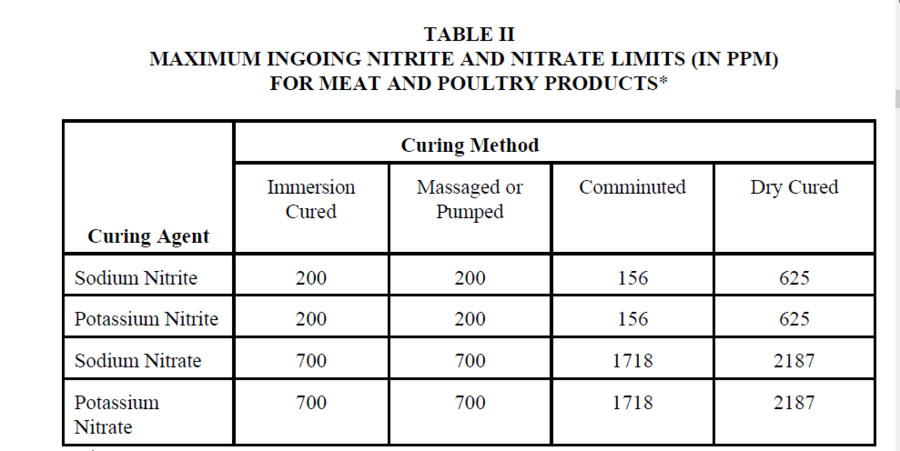These regulations are confusing at best... The regs are intertwined with different processes and final use of certain cuts of meats... Many of us have spent countless hours interpreting and defining these regs...
When you decide you would like our "opinions", there are several members on this forum that have "deciphered" the seemingly endless innuendos within the reg pamphlet... Definitions of some of their terms can confuse the use of nitrite and nitrate when curing meats...
http://www.aamp.com/foodsafety/documents/Directive7620-3.pdf
* There are more stringent limits for curing agents in bacon to reduce the formation of nitrosamines. For this same reason, nitrate is no longer
permitted in any bacon (pumped and/or massaged, dry cured, or immersion cured). Refer to page 27, Nitrite used in Bacon, for specific information.
As a matter of policy, the Agency requires a
minimum of 120 ppm of ingoing nitrite in
all cured
"Keep Refrigerated" products, unless the establishment can demonstrate that safety is assured by
some other preservation process, such as thermal processing, pH or moisture control. This 120
ppm policy for ingoing nitrite is based on safety data reviewed when the bacon standard was
developed.
There
is no regulatory minimum ingoing nitrite level for cured products that have been processed
to ensure their shelf stability (such as having undergone a complete thermal process, or having
been subjected to adequate pH controls, and/or moisture controls in combination with appropriate
packaging). However, 40 ppm nitrite is useful in that it has some preservative effect. This
amount has also been shown to be sufficient for color-fixing purposes and to achieve the expected
cured meat or poultry appearance. Some thermally processed shelf-stable (canned) products have
a minimum ingoing nitrite level that must be monitored because it is specified as a critical factor in
the product's process schedule.
Nitrite and nitrate are not permitted in baby, junior or toddler foods.
NITRITE USED IN BACON
Introduction
Because of problems associated with nitrosamine formation in bacon, MPI Regulations, section
318.7(b)(1) and (3) prescribe the amounts of nitrite and sodium ascorbate or sodium erythorbate
(isoascorbate) to be used in pumped and massaged bacon. For the immersion curing and dry
curing of bacon, maximum amounts of sodium and potassium nitrite are prescribed in section
318.7(b)(5) and (6) of the MPI Regulations.
28
Establishment management must submit pickle formulas and the method(s) of preparing
pumped
and/or massaged bacon to the processing staff officer at the appropriate regional office. The
pickle formula and targeted percent pump or pick-up must meet the limits listed below. Once the
procedure is approved, production may begin.
Regardless of the curing method used, restricted ingredient calculations for bacon are based on
the
green weight of the skinless belly. For rind-on bacon, e.g., where the skin is sold as part of
the finished product, a restricted ingredient conversion calculation is necessary.
Nitrate is no
longer permitted in any curing method for bacon.
!
Ingredient Limits
<
Pumped and/or Massaged Bacon (rind-off): An amount of 120 ppm sodium
nitrite (or 148 ppm potassium nitrite), ingoing, is required in pumped and/or massaged bacon,
except that 100 ppm sodium nitrite (or 123 ppm potassium nitrite) is permitted with an
appropriate partial quality control program, and except that 40 - 80 ppm sodium nitrite (or 49 -
99 ppm potassium nitrite) is permitted if sugar and a lactic acid starter culture are used.
550 ppm
sodium ascorbate or sodium erythorbate (isoascorbate), ingoing, is required in pumped and
massaged bacon, in addition to any prescribed amount of nitrite.
<
Immersion Cured Bacon (rind-off): A maximum of 120 ppm of nitrite or
equivalent of potassium nitrite (148 ppm) can be used in immersion cured bacon.
Note: the
calculation method for nitrite in immersion cured bacon is the same as that for nitrite in other
immersion cured products. Refer to pages 21-24.
<
Dry Cured Bacon (rind-off): A maximum of 200 ppm of nitrite or equivalent of
potassium nitrite (246 ppm) can be used in dry cured bacon.
Note: the calculation method for
nitrite in dry cured bacon is the same as that for nitrite in other dry cured products. Refer to
pages 24-27.
<
Pumped, Massaged, Immersion Cured, or Dry Cured Bacon (rind-on): The
maximum limit for ingoing nitrite and sodium ascorbate or sodium erythorbate must be adjusted if
bacon is prepared from pork bellies with attached skin (rind-on). A pork belly's weight is
comprised of approximately 10 percent skin. Since the skin retains practically no cure solution or
cure agent, the maximum ingoing nitrite and sodium ascorbate or erythorbate limits must be
reduced by 10 percent. For example, the maximum ingoing limit for nitrite and sodium ascorbate
or erythorbate for pumped pork bellies with attached skin would be 108 ppm [120 ppm ! 12 ppm
(120 × .10)] and 495 ppm [550 ppm ! 55 ppm (550 × .10)], respectively.





